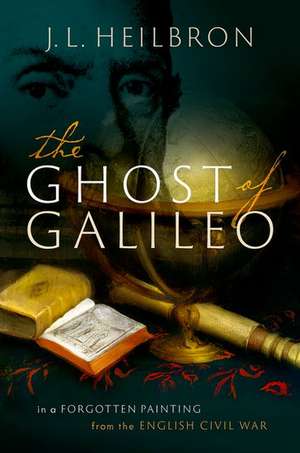The Ghost of Galileo: In a forgotten painting from the English Civil War
Autor J.L. Heilbronen Limba Engleză Hardback – 28 ian 2021
Preț: 166.78 lei
Preț vechi: 205.75 lei
-19% Nou
Puncte Express: 250
Preț estimativ în valută:
31.92€ • 34.69$ • 26.83£
31.92€ • 34.69$ • 26.83£
Carte disponibilă
Livrare economică 21-27 martie
Livrare express 15-21 martie pentru 98.77 lei
Preluare comenzi: 021 569.72.76
Specificații
ISBN-13: 9780198861300
ISBN-10: 0198861303
Pagini: 528
Ilustrații: Full colour images throughout
Dimensiuni: 165 x 245 x 35 mm
Greutate: 1.13 kg
Editura: OUP OXFORD
Colecția OUP Oxford
Locul publicării:Oxford, United Kingdom
ISBN-10: 0198861303
Pagini: 528
Ilustrații: Full colour images throughout
Dimensiuni: 165 x 245 x 35 mm
Greutate: 1.13 kg
Editura: OUP OXFORD
Colecția OUP Oxford
Locul publicării:Oxford, United Kingdom
Recenzii
The Ghost of Galileo is... a work of serious scholarship... it is brilliant, and unlike anything I expect to read all year.
... insightful and unusual... A massive amount of information is conveyed in a lively style, with a nice line in deadpan humour... a generous and original book.
If ever a book has defied summary, this is it. Mr. Heilbron takes his readers on an exhilarating, 500-page ride through the first half of the 17th century, beginning with the tangled web of political and intellectual relations between the English and the Italians, specifically the quarrel between worldly, pleasure-loving Venice and authoritarian, stuck-up Rome...
Beginning with the painting itself and following a number of threads in weaving together - in a way that truly shows the humanities at their best - the history of science, art history, the history of religion, and political history of the early modern period, Prof. Heilbron explores the social, religious, artistic, and scientific landscapes of that time.
This is a strikingly unusual book. In 2010, the year in which the author's definitive biography of Galileo and his work was published, the author chanced upon an unusual double portrait by a now unjustly little-known artist, in the dark upper corridor of a house in Dorset belonging to the National Trust ... It is a puzzle without a definitive solution, but the search for one is utterly absorbing.
This splendid study reanimates a portrait of an English scholar and his student, taking as its focal point a copy of Galileo's recent Dialogue concerning the Two Chief World Systems. The relationship of this curious foreground detail to the big picture will captivate historians of early modern science, art, literature, politics, and religion.
... insightful and unusual... A massive amount of information is conveyed in a lively style, with a nice line in deadpan humour... a generous and original book.
If ever a book has defied summary, this is it. Mr. Heilbron takes his readers on an exhilarating, 500-page ride through the first half of the 17th century, beginning with the tangled web of political and intellectual relations between the English and the Italians, specifically the quarrel between worldly, pleasure-loving Venice and authoritarian, stuck-up Rome...
Beginning with the painting itself and following a number of threads in weaving together - in a way that truly shows the humanities at their best - the history of science, art history, the history of religion, and political history of the early modern period, Prof. Heilbron explores the social, religious, artistic, and scientific landscapes of that time.
This is a strikingly unusual book. In 2010, the year in which the author's definitive biography of Galileo and his work was published, the author chanced upon an unusual double portrait by a now unjustly little-known artist, in the dark upper corridor of a house in Dorset belonging to the National Trust ... It is a puzzle without a definitive solution, but the search for one is utterly absorbing.
This splendid study reanimates a portrait of an English scholar and his student, taking as its focal point a copy of Galileo's recent Dialogue concerning the Two Chief World Systems. The relationship of this curious foreground detail to the big picture will captivate historians of early modern science, art, literature, politics, and religion.
Notă biografică
John Heilbron is Professor of History and the Vice Chancellor Emeritus at the University of California, Berkeley, as well as an Honorary Fellow of Worcester College, Oxford. He writes about the history of the physical sciences and their wider cultural context from the 17th to the 20th centuries, and has published the definitive biography of Galileo (OUP, 2010), as well as The History of Physics: A Very Short Introduction (OUP, 2018), and Niels Bohr: A Very Short Introduction, (OUP, 2020) . Heilbron's work has won several prizes and brought him honorary doctorates from multiple universities.
